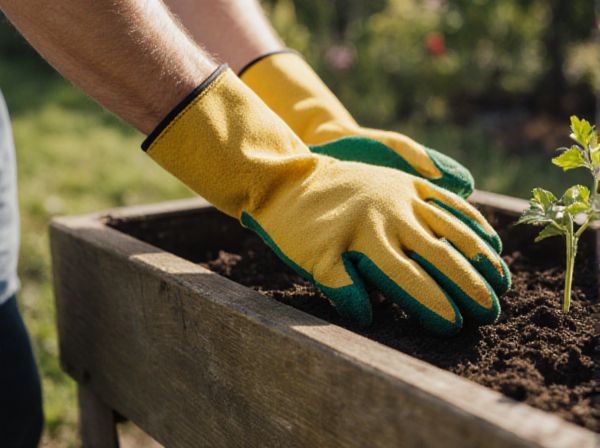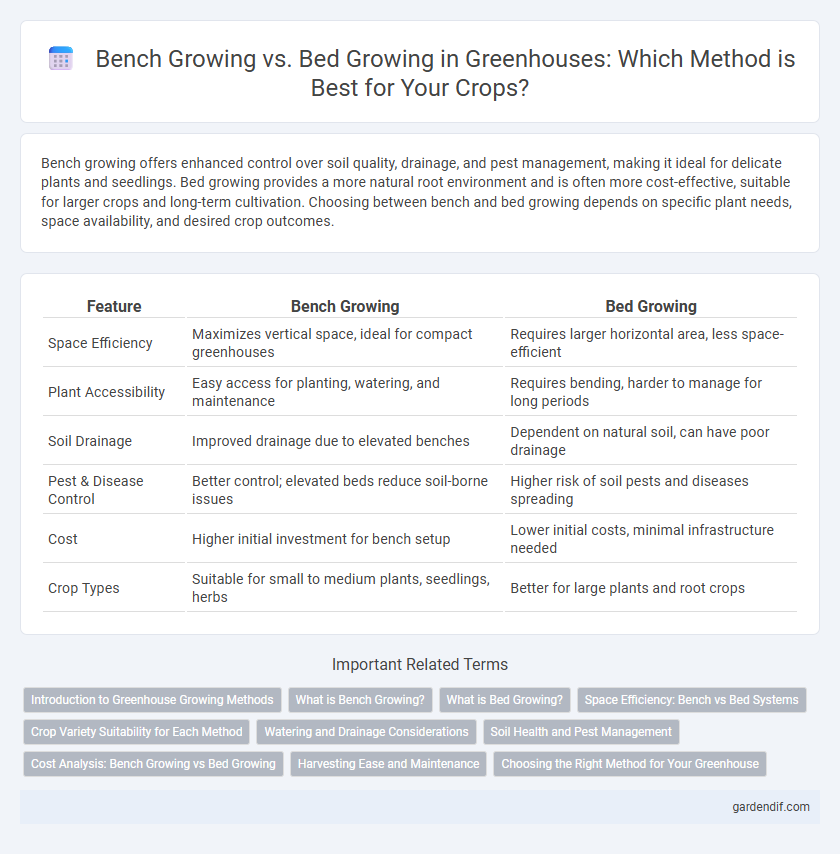
Bench Growing vs Bed Growing Illustration
Bench growing offers enhanced control over soil quality, drainage, and pest management, making it ideal for delicate plants and seedlings. Bed growing provides a more natural root environment and is often more cost-effective, suitable for larger crops and long-term cultivation. Choosing between bench and bed growing depends on specific plant needs, space availability, and desired crop outcomes.
Table of Comparison
| Feature | Bench Growing | Bed Growing |
|---|---|---|
| Space Efficiency | Maximizes vertical space, ideal for compact greenhouses | Requires larger horizontal area, less space-efficient |
| Plant Accessibility | Easy access for planting, watering, and maintenance | Requires bending, harder to manage for long periods |
| Soil Drainage | Improved drainage due to elevated benches | Dependent on natural soil, can have poor drainage |
| Pest & Disease Control | Better control; elevated beds reduce soil-borne issues | Higher risk of soil pests and diseases spreading |
| Cost | Higher initial investment for bench setup | Lower initial costs, minimal infrastructure needed |
| Crop Types | Suitable for small to medium plants, seedlings, herbs | Better for large plants and root crops |
Introduction to Greenhouse Growing Methods
Bench growing in greenhouses offers controlled elevation for plants, enhancing air circulation and ease of maintenance, which reduces pest issues and promotes uniform growth. Bed growing involves cultivating plants directly in raised soil beds within the greenhouse, allowing natural root development and better moisture retention, beneficial for crops requiring consistent hydration. Both methods optimize the greenhouse environment for temperature, humidity, and light control, crucial for maximizing plant health and yield.
What is Bench Growing?
Bench growing in greenhouses refers to cultivating plants on elevated, structured surfaces rather than directly on the ground. This method enhances air circulation, improves drainage, and facilitates easier access for maintenance and harvesting. It often uses materials like metal or wood frames with removable trays or containers, optimizing space and promoting healthier root development.
What is Bed Growing?
Bed growing involves cultivating plants directly in raised soil beds within a greenhouse, allowing better soil aeration and root development compared to containers. This method enhances water retention and nutrient availability, promoting healthier plant growth and higher yields. Greenhouse bed growing is particularly effective for crops requiring consistent moisture and controlled environmental conditions.
Space Efficiency: Bench vs Bed Systems
Bench growing systems maximize space efficiency by elevating plants, allowing for multiple tiers and better utilization of vertical space within a greenhouse. Bed growing occupies more ground area, often limiting plant density and restricting airflow, which can impact plant health and growth rates. Optimizing space with bench systems can increase crop yield per square meter and improve maintenance accessibility in controlled greenhouse environments.
Crop Variety Suitability for Each Method
Bench growing suits delicate and high-value crops like herbs, lettuce, and microgreens due to better air circulation and ease of management. Bed growing accommodates root vegetables, tomatoes, and larger crops, offering ample space and soil depth for robust root development. Selecting the appropriate method enhances crop yield and quality by matching plant growth requirements.
Watering and Drainage Considerations
Bench growing in greenhouses offers precise watering control and efficient drainage through elevated surfaces with built-in runoff systems, reducing waterlogging risks. Bed growing relies on soil's natural permeability but demands careful irrigation management to prevent uneven water distribution and potential root rot. Optimal drainage in bench systems prevents stagnant water, enhancing plant health and reducing fungal diseases common in bed cultivation.
Soil Health and Pest Management
Bench growing in greenhouses offers improved soil health by allowing better control of soil composition and moisture levels, reducing the risk of soil-borne diseases. Bed growing supports natural soil ecosystems but may require more intensive pest management due to increased exposure to soil pests and pathogens. Optimizing soil health through proper drainage and organic amendments in bench systems contributes significantly to effective pest management and overall plant vigor.
Cost Analysis: Bench Growing vs Bed Growing
Bench growing reduces initial infrastructure costs by utilizing vertical space efficiently, which lowers greenhouse footprint expenses and increases crop density. Bed growing involves higher upfront soil preparation and irrigation system installation costs but offers long-term savings through improved soil health and lower pest management expenses. Overall, bench growing presents lower short-term capital expenditure, while bed growing can deliver better cost efficiency over extended cultivation cycles.
Harvesting Ease and Maintenance
Bench growing offers easier harvesting due to elevated plant placement, reducing the need to bend and minimizing physical strain for workers. Maintenance is streamlined as benches provide better airflow and drainage, preventing soil compaction and reducing pest issues. Bed growing, while traditional, often requires more labor-intensive upkeep and can complicate harvesting because plants are closer to the ground and soil conditions may vary.
Choosing the Right Method for Your Greenhouse
Bench growing optimizes space by allowing easy access to plants and promoting better air circulation, making it ideal for high-value crops and frequent maintenance. Bed growing offers a more natural soil environment, benefiting root development and retaining moisture, which suits larger crops and longer growing cycles. Selecting the right method depends on crop type, available space, and maintenance preferences in your greenhouse setup.
Bench Growing vs Bed Growing Infographic

 gardendif.com
gardendif.com